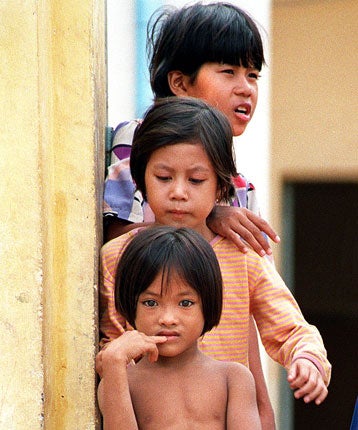Cambodia's orphanages target the wallets of well-meaning tourists

Your support helps us to tell the story
From reproductive rights to climate change to Big Tech, The Independent is on the ground when the story is developing. Whether it's investigating the financials of Elon Musk's pro-Trump PAC or producing our latest documentary, 'The A Word', which shines a light on the American women fighting for reproductive rights, we know how important it is to parse out the facts from the messaging.
At such a critical moment in US history, we need reporters on the ground. Your donation allows us to keep sending journalists to speak to both sides of the story.
The Independent is trusted by Americans across the entire political spectrum. And unlike many other quality news outlets, we choose not to lock Americans out of our reporting and analysis with paywalls. We believe quality journalism should be available to everyone, paid for by those who can afford it.
Your support makes all the difference.The Cambodian government has started inspecting more than 250 orphanages after it was revealed that most of the country's 12,000 orphans have at least one living parent. The government said that until the assessment is completed, it had no idea whether the children were being cared for properly.
Aid groups suspect that those running homes for children are enticing more parents to give up their children with promises of food, shelter and, crucially in Cambodia, education. In return, those running orphanages can expect larger donations from charities and Western tourists, who are encouraged to visit homes.
Richard Bridle, the country representative of the UN children's agency Unicef, said research had indicated 28 per cent of children in orphanages had lost both parents, raising the question about why thousands of others with at least one surviving parent were in institutional care. Unicef has also expressed concern at the near doubling of orphanage numbers from 153 to 269 in the last five years. Just 21 are state-run; the rest operate privately, and many of those are faith-based.
"Overseas donors are the main funders of residential care, and many residential-care centres have begun to turn to tourism to attract funders, and in doing so, are putting children at risk," Mr Bridle said.
The rate of growth in the number of Cambodia's orphanages over the past five years matches the increase in the number of tourists visiting the country during the same period. Visitors to Cambodia's three main tourist areas – Phnom Penh, the temple city of Siem Reap and the beach resort town of Sihanoukville – are regularly bombarded with offers to visit private orphanages and donate money.
Guesthouses commonly display posters asking travellers to visit particular orphanages. One poster promoting an orphanage in Phnom Penh says people can help "in many different areas", from teaching English and playing with the children to donating food, toys, educational materials and cash. Another orphanage displayed the appeal: "Children in Cambodia need your help!" Mr Bridle said even those tourists and volunteers who visited with good intentions were sustaining a system that was separating children from their families.
Although Unicef recognises orphanages had a place, institutional care should be a last resort, he said. It was far better for the children – and far cheaper – to have children looked after by a parent or in the community.
Sebastien Marot, the head of Friends International, a charity for street children, said orphanage tourism was simply a cynical marketing ploy that exploited children. "The system is very simple," he said. "You put a few poor-looking, sad-looking children in a centre and you try to attract tourists."
The money that tourists leave typically did not benefit the children, because, "otherwise you're breaking the business", he said. "So the money goes elsewhere and the children are maintained in the situation of poverty, looking poor and so you attract more tourists and make more money."
Join our commenting forum
Join thought-provoking conversations, follow other Independent readers and see their replies
Comments